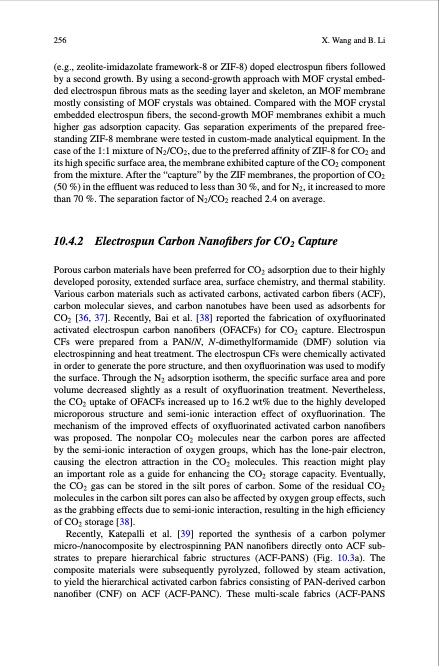
PDF Publication Title:
Text from PDF Page: 008
256 X. Wang and B. Li (e.g., zeolite-imidazolate framework-8 or ZIF-8) doped electrospun fibers followed by a second growth. By using a second-growth approach with MOF crystal embed- ded electrospun fibrous mats as the seeding layer and skeleton, an MOF membrane mostly consisting of MOF crystals was obtained. Compared with the MOF crystal embedded electrospun fibers, the second-growth MOF membranes exhibit a much higher gas adsorption capacity. Gas separation experiments of the prepared free- standing ZIF-8 membrane were tested in custom-made analytical equipment. In the case of the 1:1 mixture of N2/CO2, due to the preferred affinity of ZIF-8 for CO2 and its high specific surface area, the membrane exhibited capture of the CO2 component from the mixture. After the “capture” by the ZIF membranes, the proportion of CO2 (50 %) in the effluent was reduced to less than 30 %, and for N2, it increased to more than 70 %. The separation factor of N2/CO2 reached 2.4 on average. 10.4.2 Electrospun Carbon Nanofibers for CO2 Capture Porous carbon materials have been preferred for CO2 adsorption due to their highly developed porosity, extended surface area, surface chemistry, and thermal stability. Various carbon materials such as activated carbons, activated carbon fibers (ACF), carbon molecular sieves, and carbon nanotubes have been used as adsorbents for CO2 [36, 37]. Recently, Bai et al. [38] reported the fabrication of oxyfluorinated activated electrospun carbon nanofibers (OFACFs) for CO2 capture. Electrospun CFs were prepared from a PAN/N, N-dimethylformamide (DMF) solution via electrospinning and heat treatment. The electrospun CFs were chemically activated in order to generate the pore structure, and then oxyfluorination was used to modify the surface. Through the N2 adsorption isotherm, the specific surface area and pore volume decreased slightly as a result of oxyfluorination treatment. Nevertheless, the CO2 uptake of OFACFs increased up to 16.2 wt% due to the highly developed microporous structure and semi-ionic interaction effect of oxyfluorination. The mechanism of the improved effects of oxyfluorinated activated carbon nanofibers was proposed. The nonpolar CO2 molecules near the carbon pores are affected by the semi-ionic interaction of oxygen groups, which has the lone-pair electron, causing the electron attraction in the CO2 molecules. This reaction might play an important role as a guide for enhancing the CO2 storage capacity. Eventually, the CO2 gas can be stored in the silt pores of carbon. Some of the residual CO2 molecules in the carbon silt pores can also be affected by oxygen group effects, such as the grabbing effects due to semi-ionic interaction, resulting in the high efficiency of CO2 storage [38]. Recently, Katepalli et al. [39] reported the synthesis of a carbon polymer micro-/nanocomposite by electrospinning PAN nanofibers directly onto ACF sub- strates to prepare hierarchical fabric structures (ACF-PANS) (Fig. 10.3a). The composite materials were subsequently pyrolyzed, followed by steam activation, to yield the hierarchical activated carbon fabrics consisting of PAN-derived carbon nanofiber (CNF) on ACF (ACF-PANC). These multi-scale fabrics (ACF-PANSPDF Image | Electrospun Nanofibrous Sorbents

PDF Search Title:
Electrospun Nanofibrous SorbentsOriginal File Name Searched:
wang_chapter_2014.pdfDIY PDF Search: Google It | Yahoo | Bing
Sulfur Deposition on Carbon Nanofibers using Supercritical CO2 Sulfur Deposition on Carbon Nanofibers using Supercritical CO2. Gamma sulfur also known as mother of pearl sulfur and nacreous sulfur... More Info
CO2 Organic Rankine Cycle Experimenter Platform The supercritical CO2 phase change system is both a heat pump and organic rankine cycle which can be used for those purposes and as a supercritical extractor for advanced subcritical and supercritical extraction technology. Uses include producing nanoparticles, precious metal CO2 extraction, lithium battery recycling, and other applications... More Info
| CONTACT TEL: 608-238-6001 Email: greg@infinityturbine.com | RSS | AMP |